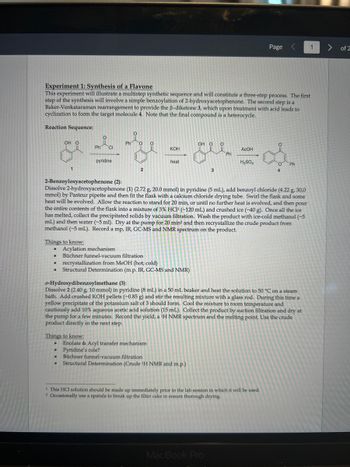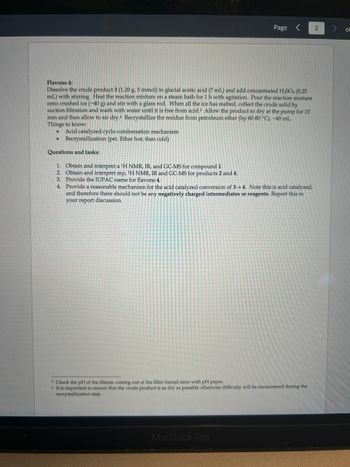
Chemistry
10th Edition
ISBN: 9781305957404
Author: Steven S. Zumdahl, Susan A. Zumdahl, Donald J. DeCoste
Publisher: Cengage Learning
expand_more
expand_more
format_list_bulleted
Concept explainers
Question
thumb_up100%
I need help calculating the theoretical yield of the product(s) for this experiment. I’m not sure if I only need the theoretical yield for Flavone 4 or if I need to find it for 1, 2, 3, and 4, so if it’s possible please calculate it for all 4. Also please specify the limiting reagent! The experiment information is in the photos.

Transcribed Image Text:Experiment 1: Synthesis of a Flavone
This experiment will illustrate a multistep synthetic sequence and will constitute a three-step process. The first
step of the synthesis will involve a simple benzoylation of 2-hydroxyacetophenone. The second step is a
Baker-Venkataraman rearrangement to provide the ß-diketone 3, which upon treatment with acid leads to
cyclization to form the target molecule 4. Note that the final compound is a heterocycle.
Reaction Sequence:
&=&==
KOH
heat
●
OH O
2-Benzoyloxyacetophenone (2):
Things to know:
●
●
1
●
Ph CI
pyridine
Acylation mechanism
● Büchner funnel-vacuum filtration
Things to know:
●
Ph
2
recrystallization from MeOH (hot; cold)
Structural Determination (m.p. IR, GC-MS and NMR)
Dissolve 2-hydroxyacetophenone (1) (2.72 g, 20.0 mmol) in pyridine (5 mL), add benzoyl chloride (4.22 g, 30,0
mmol) by Pasteur pipette and then fit the flask with a calcium chloride drying tube. Swirl the flask and some
heat will be evolved. Allow the reaction to stand for 20 min, or until no further heat is evolved, and then pour
the entire contents of the flask into a mixture of 3% HC1¹ (~120 mL) and crushed ice (~40 g). Once all the ice
has melted, collect the precipitated solids by vacuum filtration. Wash the product with ice-cold methanol (~5
mL) and then water (~5 ml). Dry at the pump for 20 min² and then recrystallize the crude product from
methanol (~5 mL). Record a mp, IR, GC-MS and NMR spectrum on the product.
● Pyridine's role?
Enolate & Acyl transfer mechanism
OH OO
● Büchner funnel-vacuum filtration
Structural Determination (Crude ¹H NMR and m.p.)
3
Ph
o-Hydroxydibenzoylmethane (3):
Dissolve 2 (2.40 g, 10 mmol) in pyridine (8 mL) in a 50 mL beaker and heat the solution to 50 °C on a steam
bath. Add crushed KOH pellets (~0.85 g) and stir the resulting mixture with a glass rod. During this time a
yellow precipitate of the potassium salt of 3 should form. Cool the mixture to room temperature and
cautiously add 10% aqueous acetic acid solution (15 mL). Collect the product by suction filtration and dry at
the pump for a few minutes. Record the yield, a ¹H NMR spectrum and the melting point. Use the crude
product directly in the next step.
ACOH
MacBook Pro
H₂SO4
Page <
1 This HCl solution should be made up immediately prior to the lab session in which it will be used.
2 Occasionally use a spatula to break up the filter cake to ensure thorough drying.
O
O Ph
4
1
> of 2

Transcribed Image Text:Flavone 4:
Dissolve the crude product 3 (1.20 g, 5 mmol) in glacial acetic acid (7 mL) and add concentrated H₂SO4 (0.25
mL) with stirring. Heat the reaction mixture on a steam bath for 1 h with agitation. Pour the reaction mixture
onto crushed ice (~40 g) and stir with a glass rod. When all the ice has melted, collect the crude solid by
suction filtration and wash with water until it is free from acid.3 Allow the product to dry at the pump for 15
min and then allow to air dry. Recrystallize the residue from petroleum ether (bp 60-80 °C), -40 mL.
Things to know:
● Acid catalyzed cyclo-condensation mechanism
Recrystallization (pet. Ether hot; then cold)
●
Questions and tasks:
1. Obtain and interpret a ¹H NMR, IR, and GC-MS for compound 1.
2. Obtain and interpret mp, ¹H NMR, IR and GC-MS for products 2 and 4.
3. Provide the IUPAC
for flavone 4.
4.
Page <
Provide a reasonable mechanism for the acid catalyzed conversion of 3-4. Note this is acid catalyzed,
and therefore there should not be any negatively charged intermediates or reagents. Report this in
your report discussion.
3 Check the pH of the filtrate coming out of the filter funnel stem with pH paper.
* It is important to ensure that the crude product is as dry as possible otherwise difficulty will be encountered during the
recrystallization step.
MacBook Pro
2
of
Expert Solution
This question has been solved!
Explore an expertly crafted, step-by-step solution for a thorough understanding of key concepts.
Step by stepSolved in 4 steps with 2 images

Knowledge Booster
Learn more about
Need a deep-dive on the concept behind this application? Look no further. Learn more about this topic, chemistry and related others by exploring similar questions and additional content below.Similar questions
- givin the answer for 1 & 2 below, provide an answer for 3: Write the balanced equation for this experiment by adding these two equations. (Note that Br2 is generated in the redox equation and consumed in the final step, thus it is considered to be a reaction intermediate and should not appear in the net equation – you will need to scale one or more of the equations before the equations are combined.)arrow_forwardCould you show me how to end up with these answers on 8 and 10 please?arrow_forwardIn a Grignard reaction, 1.4555 g phenyl bromide, 10. g carbon dioxide, 0.5734 g magnesium filings, and 30.2 mL of 6M HCl were used but only 573 mg of benzoic acid were isolated after recrystallization? what was the percent yield for the overall process? Give the answer to the nearest whole number pleasearrow_forward
- 6arrow_forwardYou are performing an extraction and you begin with 0.70 g of crude starting material. At the conclusion of this exercise, you isolate 0.52 g of pure product. Calculate a percent recovery?arrow_forward1. Complete the balanced molecular chemical equation for the reaction below. If no reaction occurs, write NR after the reaction arrow. Be sure to include the proper phases for all species within the reaction. Cu₂SO (aq) + Na₂PO₂(aq) → 2. 3. Complete the balanced molecular chemical equation for the reaction below. If no reaction occurs, write NR after the reaction arrow. Be sure to include the proper phases for all species within the reaction. Ba(CIO)₂(aq) + RbOH(aq) → Complete the balanced molecular chemical equation for the reaction below. If no reaction occurs, write NR after the reaction arrow. Be sure to include the proper phases for all species within the reaction. ZnCl₂(aq) + Hg₂(NO³)₂(aq) —arrow_forward
- 1) Explain the difference between a limiting and excess reagent. 2) A group of friend create an open-air campfire outside which burns wood. Carbon dioxide and water are produced from the burning.arrow_forward1) The case study screenshot has been attached down below and the last sentence of the story is written down below and answer ques a,b,c which is written down below as well step-by-step. The last sentence of the case study is to save money and had been reducing monitoring, inspections, and maintenance. a) Use the following reaction to determine how much of each product would be released if 42 000 kg (42 tonnes) of methyl isocyanate reacted with excess water. This is the reaction methyl isocyanate + water -> 1,3-dimethyl urea + carbon dioxide b) Create a list of mistakes that led to the Bhopal disaster; you should be able to find at least eight. Evaluate the list of mistakes. Identify the three mistakes you think were most significant in causing the disaster, and justify your choice in a short (2-3 senstence) statement. c) What are some reasons it would have been safer to store the methyl isocyanate in smaller containers? Identify at least three reasons.arrow_forwardCan you answer all parts to this question Theoretical yield of pinacolone in grams and moles show your calculations Final yield of pinacolone (grams and % yield) show your calculationsarrow_forward
- find theoretical yield of 102 mg of 4-tert-butylhexane equation is C10H18O please show work. table with info attachedarrow_forwardMatch each of the following hydrocarbons to the sum of the oefents of its balanced combustion reaction. For example, sum of coefficients of C2H4 + 3 O2 → 2 H2O + 2 CO2 is 1 + 3 + 2 + 2 = 7. If you are having trouble with this exercise, this video will help. 000 21 41 19 45 A 1. C7H8 2. C5H12 3. C6H8 4. C7H10arrow_forwardYou begin the reaction with 6.5 mL of t-butyl alcohol (density= 0.775 grams/mL) and 15 mL of concentrated HCl (1.189 grams/mL, 38% HCl) in a distillation flask. Calculate the limiting reagent and the theroretical yield of the product (t-butyl chloride) for this reaction. (Hint:Your starting amount of HCl is 38% of the starting smount).arrow_forward
arrow_back_ios
arrow_forward_ios
Recommended textbooks for you
 ChemistryChemistryISBN:9781305957404Author:Steven S. Zumdahl, Susan A. Zumdahl, Donald J. DeCostePublisher:Cengage Learning
ChemistryChemistryISBN:9781305957404Author:Steven S. Zumdahl, Susan A. Zumdahl, Donald J. DeCostePublisher:Cengage Learning ChemistryChemistryISBN:9781259911156Author:Raymond Chang Dr., Jason Overby ProfessorPublisher:McGraw-Hill Education
ChemistryChemistryISBN:9781259911156Author:Raymond Chang Dr., Jason Overby ProfessorPublisher:McGraw-Hill Education Principles of Instrumental AnalysisChemistryISBN:9781305577213Author:Douglas A. Skoog, F. James Holler, Stanley R. CrouchPublisher:Cengage Learning
Principles of Instrumental AnalysisChemistryISBN:9781305577213Author:Douglas A. Skoog, F. James Holler, Stanley R. CrouchPublisher:Cengage Learning Organic ChemistryChemistryISBN:9780078021558Author:Janice Gorzynski Smith Dr.Publisher:McGraw-Hill Education
Organic ChemistryChemistryISBN:9780078021558Author:Janice Gorzynski Smith Dr.Publisher:McGraw-Hill Education Chemistry: Principles and ReactionsChemistryISBN:9781305079373Author:William L. Masterton, Cecile N. HurleyPublisher:Cengage Learning
Chemistry: Principles and ReactionsChemistryISBN:9781305079373Author:William L. Masterton, Cecile N. HurleyPublisher:Cengage Learning Elementary Principles of Chemical Processes, Bind...ChemistryISBN:9781118431221Author:Richard M. Felder, Ronald W. Rousseau, Lisa G. BullardPublisher:WILEY
Elementary Principles of Chemical Processes, Bind...ChemistryISBN:9781118431221Author:Richard M. Felder, Ronald W. Rousseau, Lisa G. BullardPublisher:WILEY

Chemistry
Chemistry
ISBN:9781305957404
Author:Steven S. Zumdahl, Susan A. Zumdahl, Donald J. DeCoste
Publisher:Cengage Learning

Chemistry
Chemistry
ISBN:9781259911156
Author:Raymond Chang Dr., Jason Overby Professor
Publisher:McGraw-Hill Education

Principles of Instrumental Analysis
Chemistry
ISBN:9781305577213
Author:Douglas A. Skoog, F. James Holler, Stanley R. Crouch
Publisher:Cengage Learning

Organic Chemistry
Chemistry
ISBN:9780078021558
Author:Janice Gorzynski Smith Dr.
Publisher:McGraw-Hill Education

Chemistry: Principles and Reactions
Chemistry
ISBN:9781305079373
Author:William L. Masterton, Cecile N. Hurley
Publisher:Cengage Learning

Elementary Principles of Chemical Processes, Bind...
Chemistry
ISBN:9781118431221
Author:Richard M. Felder, Ronald W. Rousseau, Lisa G. Bullard
Publisher:WILEY